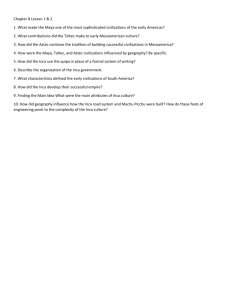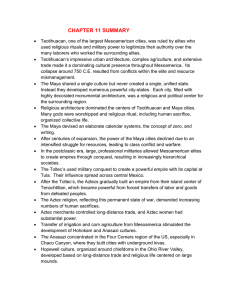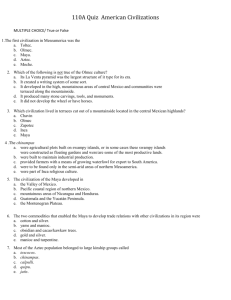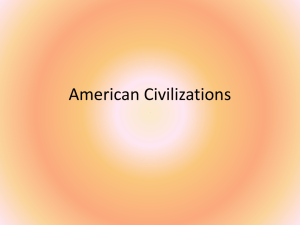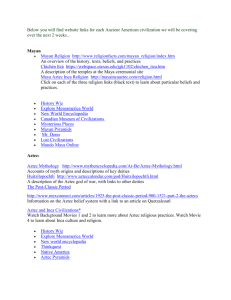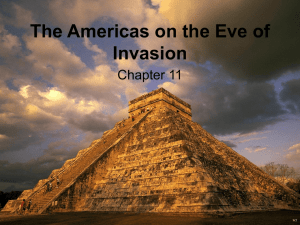The Americas on the Eve of Invasion
advertisement
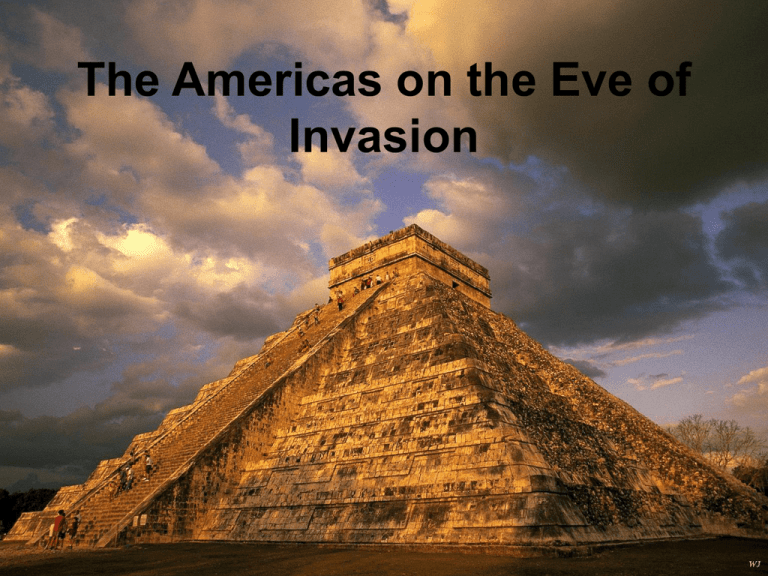
The Americas on the Eve of Invasion Civilizations in the Americas • Created thriving civilizations – Political organization – Advanced math, astronomy – Agricultural techniques – Population growth and urbanization – Social Stratification – Developed economies & trade • Important Civilizations: – Maya, Aztec, Inca Maya • Tropical Climate, poor soil • Variety of ag. techniques depending on environment – Slash & burn (aka swidden agriculture) – Drain swamps for land – terracing • Government: – Series of rival kingdoms w/ hereditary rulers • Rulers serve both political & religious function Maya Empire http://www.adishakti.org/images_foreign/mayamap_L.gif Maya • Religion – 3 layer cosmos (underworld, human world, heavens) – Close tie b/t warfare and religion • Rituals & fasting before war • Use of war to gain captives – Many used for human sacrifice; others for labor – Bloodletting, tattooing, painting of skin – Elaborately decorated temples Maya • Science/Technology – Sophisticated calendar-making – Hieroglyphic writing system – Concept of zero in mathematics Maya • Collapse of the Maya – Cities abandoned between 800 and 900 – Possible reasons • Disease • Decline in trade (likely associated with fall of Teotihuacán) • Environmental degradation • Decline in agricultural production • Internal warfare Aztec Mexica (Meh-she-ca) • Moved into Central Mexico • Began to buildup powerbase near Lake Texcoco • 1325: construction on Tenochtitlan & Tlateloco – Twin capitals- Foundation of Mexico City • Began to expand & create an empire Aztec http://www.plu.edu/~arnoldwp/img/aztec-empire.jpg Aztec • Government: – Single ruler chosen by council of aristocrats – Ruler chosen from royal family – New rulers expected to engage in military conquest to display their power • Tie between war and religious ceremony Aztec • Social Structure: – Social & economic inequality – Little opportunity for social mobility – Elites used ceremony & ritual to distinguish themselves • Better diet, richer clothing, nicer homes, different marriage practices (ie. Commoners were monogamous, elites polygamous) Aztec • Economy: – Relied upon agriculture • used chinampas (floating gardens) to increase ag. – Tribute system supplied other goods to city • Conquered peoples sent food, cloth, luxury items, military equipment, and sacrificial victims to city – Trade important • Barter system Aztec • Religion: – Polytheistic – Twin temple dedicated to gods – Extensive use of human sacrifice • Thousands annually • Both religious and political function – Believed gods lived off human hearts and blood – Public sacrifice helped deter rebellion and opposition Andean Civilizations • In South America, a series of cultures grew in a most unlikely place – Harsh environment • Mountains (Andes) • Desert along west coast (Atacama) • Rainforest to the east • Andean civilizations typically followed the same plan for organization of society and the economy Andean Civilization • Economy: – Eac state was organized in a system known as mitá • System required communities to contribute workers to perform various forms of labor • Colonies were also sent out to exploit resources in the area – Used various ag. techniques to improve productivity • Irrigation, terracing, etc. – All goods produced were then brought together for exchange • Use of quipu to keep records – Series of knotted colored cords http://www.orquidea.net/peru_travel_center/inca_empire.jpg Inca • The Inca began as a chiefdom; expands its power in the 1430’s – Developed an imperial state in the Andes Mountains of South America – By 1525, population of over 6 million • Capital: Cuzco (Peru) http://www.anntravelcorp.com/fotos/p000001_ cuzco%20anntravel.jpg Machu Picchu City constructed at height of Inca Empire Inca • Buildup of military • Government: – Rulers began reign with military conquest to prove their power • Created a bureaucracy composed of rulers kinsmen – Military conquest • Left local rulers of conquered peoples in place – Heirs of the rulers taken hostage to ensure cooperation Inca • Achievements of the Inca: – Skilled at stone work – Cuzco constructed to look like a Mountain Lion • Palaces and temples • Temple of the Sun – Astronomical observation conducted by priests – Calendar-making Inca • Highly structured, government-regulated economy led to prosperity • However, imperial system created a system of inequality • 1525: Stage is set for European conquest when the Inca were weakened by internal division – Ruler died, triggering a power struggle between his two sons – Civil war weakens the Inca • Making them vulnerable to Europeans
